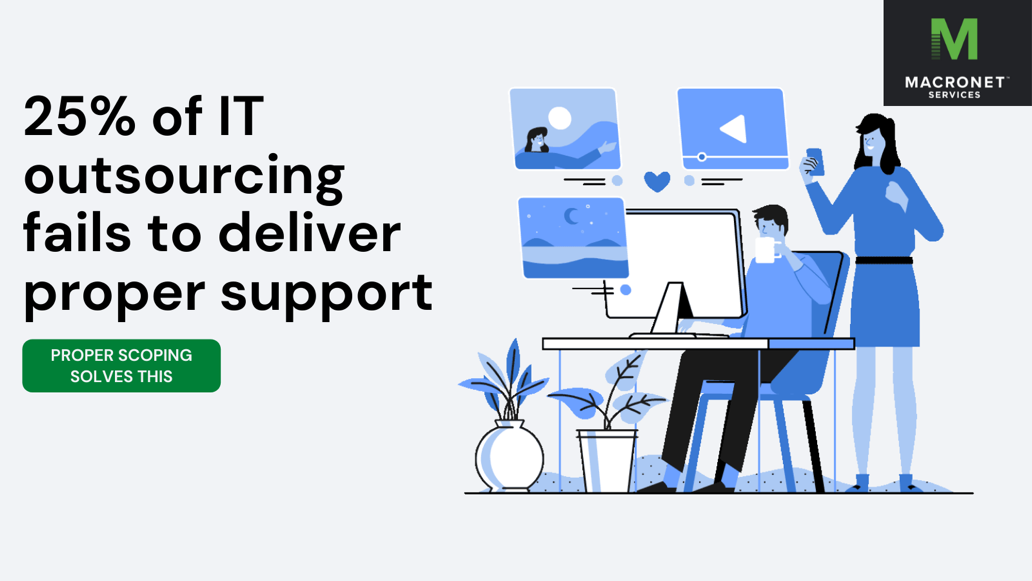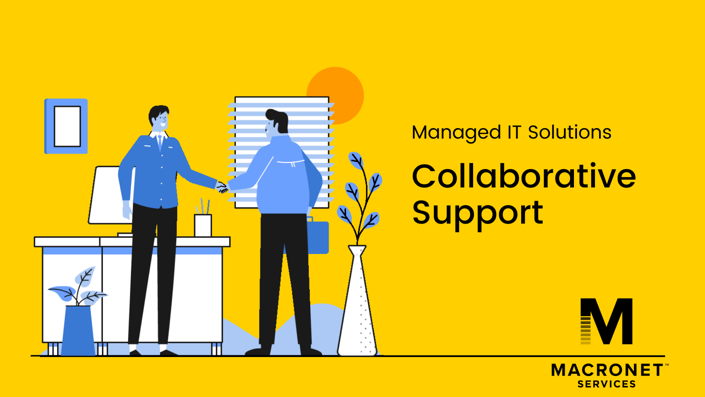The (Better) Managed IT Solutions Playbook for 2023
What are Managed IT Solutions in 2022?
Managed IT Solutions provide comprehensive technology services for enterprises on a 24×7 basis. Often, these services are an augmentation of existing IT teams support covering off-hours, niche products or less critical but time-consuming tasks. Organizations who require on-premises(office) remote worker, public cloud and security suites can take advantage of a managed or co-managed IT solution. Managed Service Providers (MSPs) deep experience across the entire OSI model helps promote a thriving technology support ecosystem especially as trends & needs change almost daily.
In 2022, more organizations will begin to leverage a combination of outsourced solutions for areas less critical time consuming for an existing IT Team. Or companies will look to completely outsource certain office locations dive into allowing a Managed IT firm to support the entire enterprise. An article last year talked about 6 Trends Shaping The Managed Services Market
5 Managed IT support services you can take advantage of in 2022.
- Office365 has enabled many organizations the efficiency to build a virtual environment capable of remote work while recovering from disastrous things such as a lost laptop! Outsourcing some of the functions within O365 will improve your organization’s efficiency to focus on more critical areas of the business such as cloud, SDWAN support etc. The migration alone from an Active Directory or other platform to Office365 does eat into precious staff time while other tasks come to a halt during the transition. Other considerations such as data retention with Microsoft Office 365 is limited, generally to 30 daysand that does not work for most organizations.
Areas you can outsource Office365
- Password resets & hygiene
- Network infrastructure
- Data security, anti-spam, phishing
- DNS/Domain issues
- Training time to stay ahead of O365 enhancements
- GSuite similar to O365 and upkeep of licenses, storage and add/delete of users, GSuite has another area of concentration for many companies – training needs. While many startups or cloud native teams have opted for Google Services, their hiring of “tenured” individuals can pose a gap. Many from a legacy Enterprise in the “Microsoft” world can be unfamiliar with the slick options in Gmail or google drive itself. Often, employees find themselves confused and requiring help on how to use their new MacBook and Google Docs setup. (What do you mean there isn’t PowerPoint or Excel?). Leveraging support for GSuite is a great way to support your Zendesk tickets while keeping a happy workforce from trying to figure out the new atl-tab feature, ha.
- Remote Workers IT Support often require Network, Cloud VPN, bandwidth, SaaS and voice/collaboration application needs. These employees all come with a variety of home broadband, premise devices (or lack of) voice and video needs. Standardization of Remote Worker devices and Tier-1 help desk support alleviates a huge burden on the enterprise IT organization. (How come my cable modem is not blinking?). Plus, it also enables additional layer of security for public IaaS and SaaS applications required to connect. (Que the O365 and Gmail horn!).
- Network Monitoring of carrier circuits to keep a watch on a 24×7 basis so they stay operational and if not, open a trouble ticket with your carrier before the sun rises. As more companies opt for SDWANreplacing legacy MPLS networks, they invariably add 1-5+ carriers in their network across Broadband, DIA and now 5G services. When a circuit goes down, it can be annoying and time consuming, opt to have this outsourced, it’s short money. However, if 5G becomes your focus in 2022, lookout as it’s not one-size fits all especially with the devices alone.
- DRaaS and Storage have become very affordable and suitable options for off-site recovery. No organization should have tape libraries remaining unless there is a compliance requirement, or someone owns a LTO company. Managed IT solutions have many different options for cloud storage and very turn-key options to off-load date. Many of our UCaaS providers include voice recording as a feature, built into their platform. This removes the need (again, ditch the Tape Library) for call centers to store this information natively.
Advantages of a Managed IT Solution:
- 24x7x365 support coverage globally including following the sunmodel provides organizations the ability to reach everywhere. Additionally, if there are multiple offices internationally with language considerations, a managed solution can offer additional support in the communication arena within country.
- Leverage peak support loads in times of work “congestion” when various projects rise above typical support requests.
- Often supports leveraging keeping costs steady where some organizations might have turnover in IT. If your support

Disadvantages:
- Selecting the wrong MSP. It happens and the quicker you can divorce yourself of the relationship and rework the support model the better.
- Pricing can creep if not managed properly and negotiated in advance clearly. You will want to really understand the basics such as term, liability, coverage, assignment but more importantly, what consists of an overage, MACD etc.
- Limitations can exist with very small MSPs and their ability to provide multiple services. It’s ok to leverage a Security MSP and a UC one independently. Just like you wouldn’t hire your mechanic to fix plumbing issues, you’ll want experts with tenure supporting the business.
Managed IT Solutions Considerations for your organization:
- Will you be supported remotely and if so, is it in country or offshore?
- Experience level & client ratio balance to support personnel. Is it a high ratio of “hundreds” of customers per IT Consultant/Engineer?
- What are their Methods Of Procedures & BCDR Planning?
- Support Request Methods? Can they integrate with existing tools you have in place such as Zendesk, Jira or ServiceNow?
- Will you have shared root access on devices?
- Certifications, Insurance levels (Cyber included)

Macronet Services IT Assessment Approach
We take understanding the core of your environment needs very seriously to position the best options for a managed or co-managed IT environment. If there is an existing IT organization, recommending co-managed options are a great way to maintain root level access across an enterprise environment but share the ability for Moves/Adds/Changes/Delete (MACD). Think about it, if you are an IT team with a tall list of responsibilities and would prefer 24×7 support to make changes off-business hours, is that advantageous vs. hiring additional support to follow the sun? Large enterprise organizations absolutely will have a 24×7 team however we can all relate that there are always tasks, sprints, maintenance, upgrades occurring off-hours. As a result, augmenting even some of the smaller, trivial areas in an IT organization make business and financial sense. A CIO/CTO may not want their best Ops person troubleshooting VOIP issue when a complete cloud WAF policy is in flight to be modified at 2AM. Conversely, if a tech team is at the inflection point of adding an additional engineer and realizes the existing team might want a vacation day, does it make sense to co-source some area tasks?
What does Macronet’s basic IT Solution assessment look like?
We begin as architects & stewards of discovery phase for many organizations before a recommended solution is provided. Why? Your company is unique, has specific use cases and as mentioned, it’s not a cookie cutter approach for all. (Again, we don’t want a mechanic, installing new plumbing). Here’s how we start at a basic level:
Managed IT Assessment questions:
- What is the goal of this project, in your own words?
- Why are you considering a new Managed Services Provider (MSP)?
| · Lack of in-house expertise | · Too many disparate systems | · Faster time to market |
| · Opex vs capex (staffing) | · Support for legacy systems | · Focus on value-add services |
| · Right-sizing & scalability | · Replace current MSP | · Other |
- Where is the IT infrastructure that will be managed?
| · On-Premises | · Colocation | · Private Cloud | · Public Cloud |
- Are you already in an outsourcing relationship for this infrastructure?
| · Yes | · No |
- Which assets do you need managed?
| · Hardware | · Operating System | · Application |
| · Public Cloud | · Security | · Network |
| · Backup | · PBX | · Other |
OPTIONAL – Feel free to attach a list of IT inventory in scope. All of the assessments we evaluate support the ability for clients
- Provide a brief list of IT inventory, with quantities, makes, and models.
Compliance Standards Required.
This is usually in the form of a (we support Microsoft, google etc.) spreadsheet, doc, Visio, lucid etc.
- Compliance Requirements
| SSAE 18 | HIPAA | PCI |
| FISMA | FedRAMP | SOX |
| GLBA | ISO 27001 | Other |
- If applicable, what are you doing to maintain compliance today?Helpful Info
- # IT Locations (in scope)
- # Total Locations
- Desired Support Model
| Onsite | · Remote | · Mix of both |
Desired Support Coverage
| · 8×5 M-F | · 24/7/365 | · Other |
- Desired Support Consumption Model?
| · Monthly rate | · Block of hours | · Retainer | · Other |
- Estimated # Tickets/Month
- Do you require Outsourced Help Desk for end users such as print, voice, remote users, video collaboration etc.?
| Yes | No |
This allows us to pull together a quick understanding of your organization, IT journey requirements. It affords us the chance to next drill into further discovery and align multiple options for you to review, price and understand responsibilities. If you would like to see the next phase in your IT Solution journey, please contact us and our architecture team will review you together.
Recent Posts
- How Laser Satellite Communication Breakthroughs Compete with Starlink
- AI-Powered Humanoid Robots: Transforming Business, Homes & Connectivity
- Top IT & Network Design Consultants in Boston and New England: Macronet Services
- Top AI Consultants in New England: Why New Hampshire’s Macronet Services Shines in Boston and Beyond
- IXPs in the US and Internet Peering
Archives
- July 2025
- June 2025
- May 2025
- April 2025
- March 2025
- February 2025
- January 2025
- December 2024
- November 2024
- October 2024
- September 2024
- August 2024
- July 2024
- June 2024
- May 2024
- April 2024
- March 2024
- February 2024
- January 2024
- December 2023
- November 2023
- October 2023
- September 2023
- August 2023
- July 2023
- June 2023
- May 2023
- April 2023
- March 2023
- February 2023
- January 2023
- December 2022
- November 2022
- October 2022
- September 2022
- August 2022
- July 2022
- June 2022
- May 2022
- April 2022
- March 2022
- February 2022
- January 2022
- December 2021
- November 2021
- October 2021
- September 2021
- August 2021
- July 2021
- June 2021
- May 2021
- April 2021
- March 2021
- December 2020
- September 2020
- August 2020
- July 2020
- June 2020
Categories
- All (19)
- Satellite (1)
- Artificial Intelligence (3)
- Travel (1)
- Sports (1)
- Music (1)
- News (271)
- Design (3)
- Clients (12)
- Uncategorized (1)
- Tips & tricks (25)
- Inspiration (9)
- Client story (1)
- Unified Communications (196)
- Wide Area Network (308)
- Cloud SaaS (60)
- Security Services (71)




